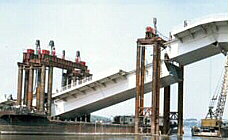 |
| Most Slobode (Freedom Bridge) used to carry the 6-lane Novi Sad-Sremska Kamenica road across the Danube River |
The Danube River has historically connected people and countries along
its 2,778-kilometer course and has inspired many poets and composers. Practical
minds have recognized the unique opportunity the River provides for cost-effective
and environmentally friendly transportation. In the 1980s and early 1990s,
about 100 million tons of goods were carried annually along the Danube.
Economists calculate that if this cargo had had to be carried by land, about
19,000 more trucks would have had to circulate on the roads annually, puffing
fumes and jamming crossroads and border crossings.
The three bridges in Novi Sad destroyed during the military operations in
Yugoslavia in 1999 effectively blocked the entire navigation on the River.
The shipping industry alone, without indirect negative effects on agriculture
and other industries, suffered losses estimated at EUR1m a day.
In order to address the problem, the Danube Navigation Commission initiated
a clearance project, for which the European Union provided 85 per cent of
the required EUR26m, while the remaining funds were contributed by Austria,
Bulgaria, Canada, Croatia, Germany, Hungary, the Netherlands, Romania, Russia,
Slovakia, Switzerland and Ukraine.
In order to ensure that the clearance works do not additionally harm the
River, a thorough environmental impact assessment (EIA) study was carried
out. An ad-hoc working group consisting of representatives of all relevant
Yugoslav authorities, the ICPDR and the Danube Navigation Commission, was
established to monitor the EIA process. The EIA report was made available
to the citizens of Novi Sad for public scrutiny.
 |
| Clearance work requires serious technical knowledge and a huge effort |
The actual clearance work started with a thorough screening for unexploded
ordnance along the entire stretch of the River covered by the project. In
order to minimise the losses in navigation, as soon as sufficient security
was guaranteed, a temporary fairway was mapped with the capacity of 800-1000
ships per month, which was deemed sufficient for the clearance period.
Physical removal of the debris of the bridges started in April 2002. The
debris of Zezelj Bridge, in the south of the city, was the first to be cleared
by October 2002. The last remainings of Petrovaradin Bridge, near the centre
of Novi Sad, will be removed in the near future, but the navigation channel
is already completely free.
The debris of the newest and most modern of the city’s bridges, Most
Slobode, posed a slightly more serious challenge since sedimentation, water
level and the stream created additional difficulties. Regardless of some
delays, it is hoped that the clearance of this bridge will be finished by
the summer of 2003. As soon as the bulk of the debris was removed, the restoration
of the riverbed started in October 2002.
The Danube Clearance Project is an example of successful and creative international
cooperation which is turning a grim situation into a new opportunity and
in which two international bodies – the ICPDR and the Danube Navigation
Commission – have successfully cooperated in order to ensure the best
possible protection of the riverine environment.